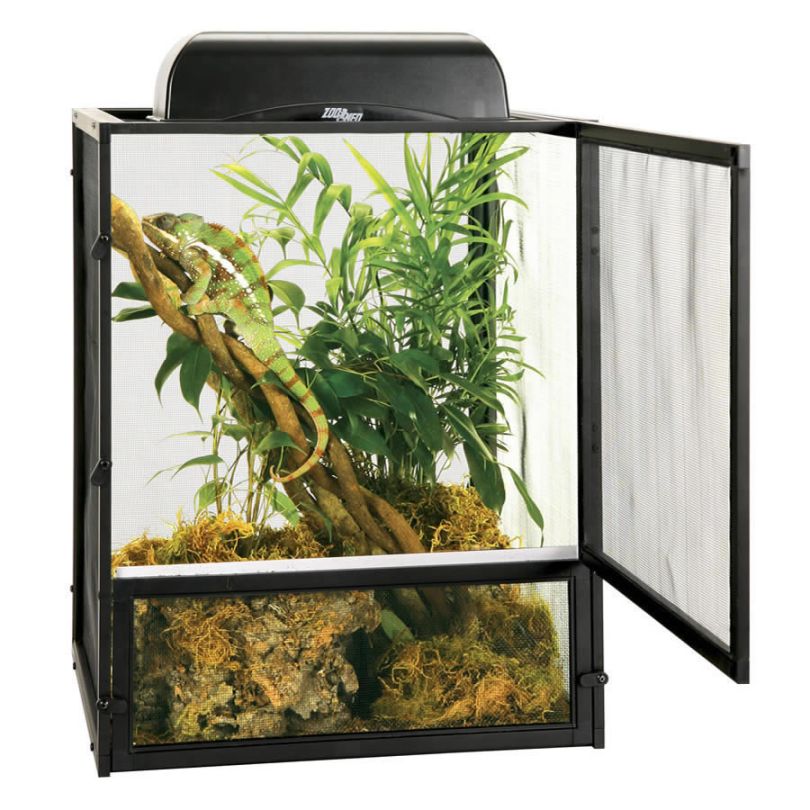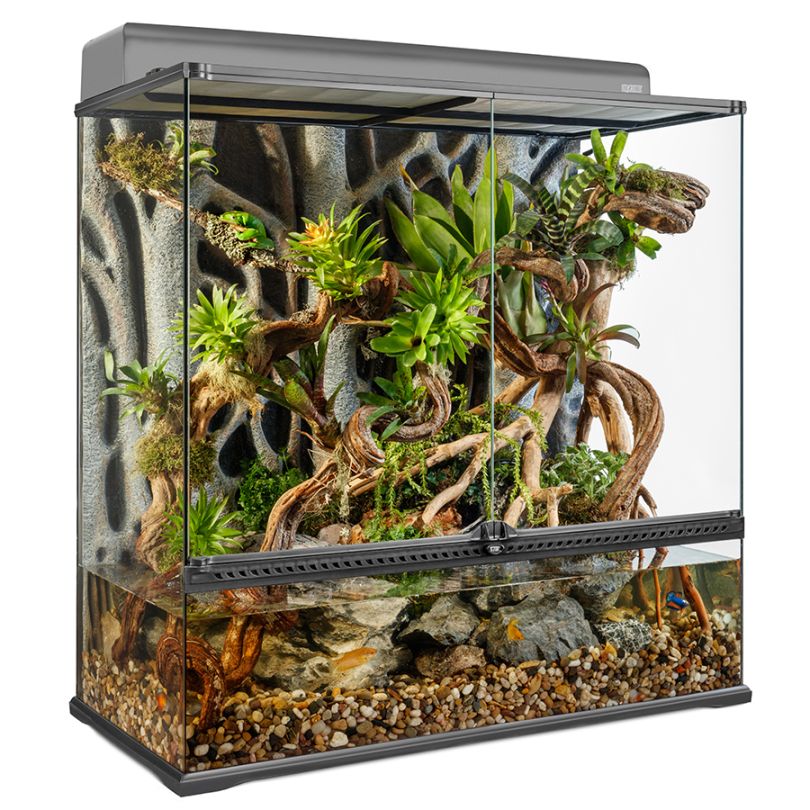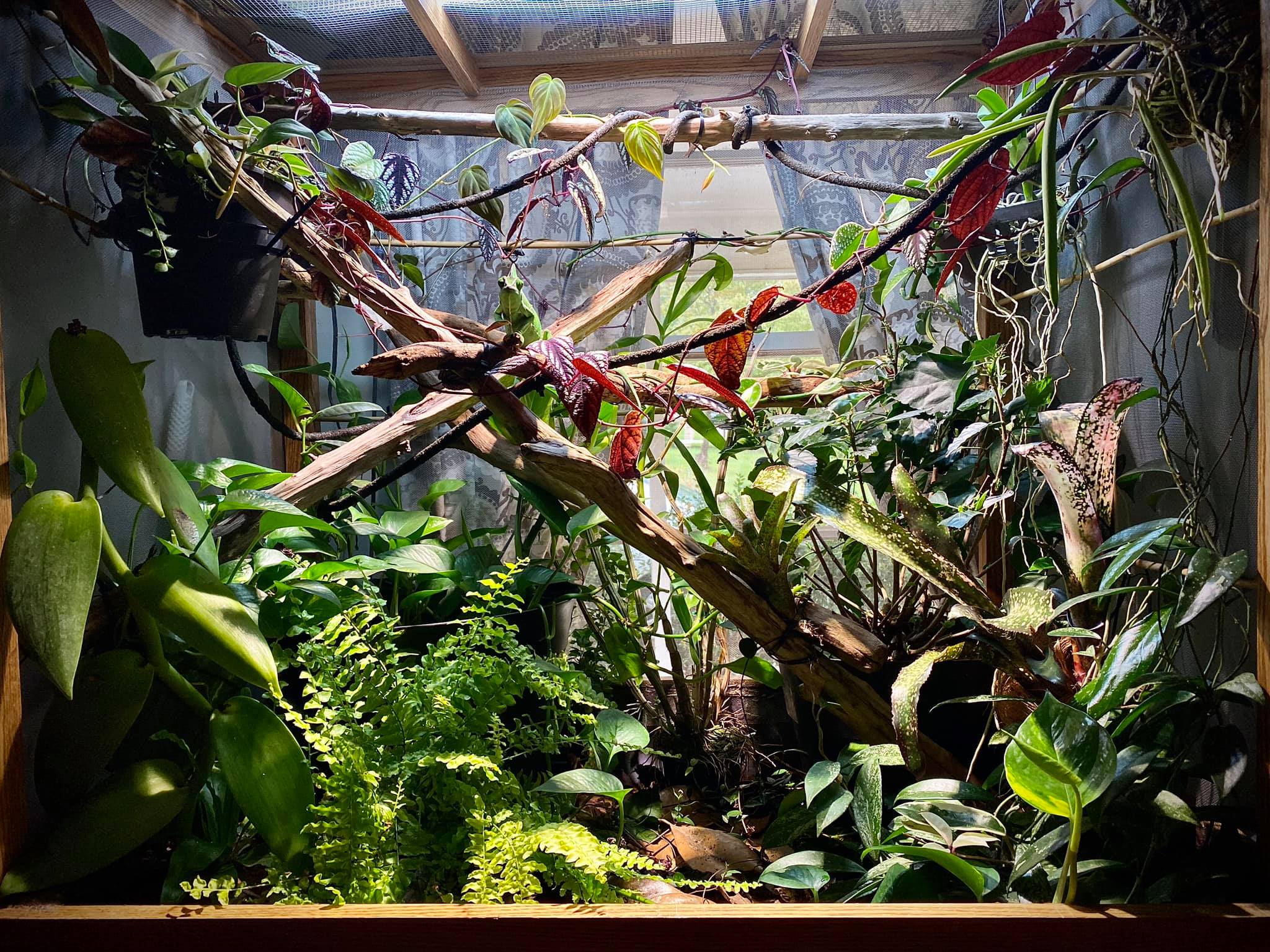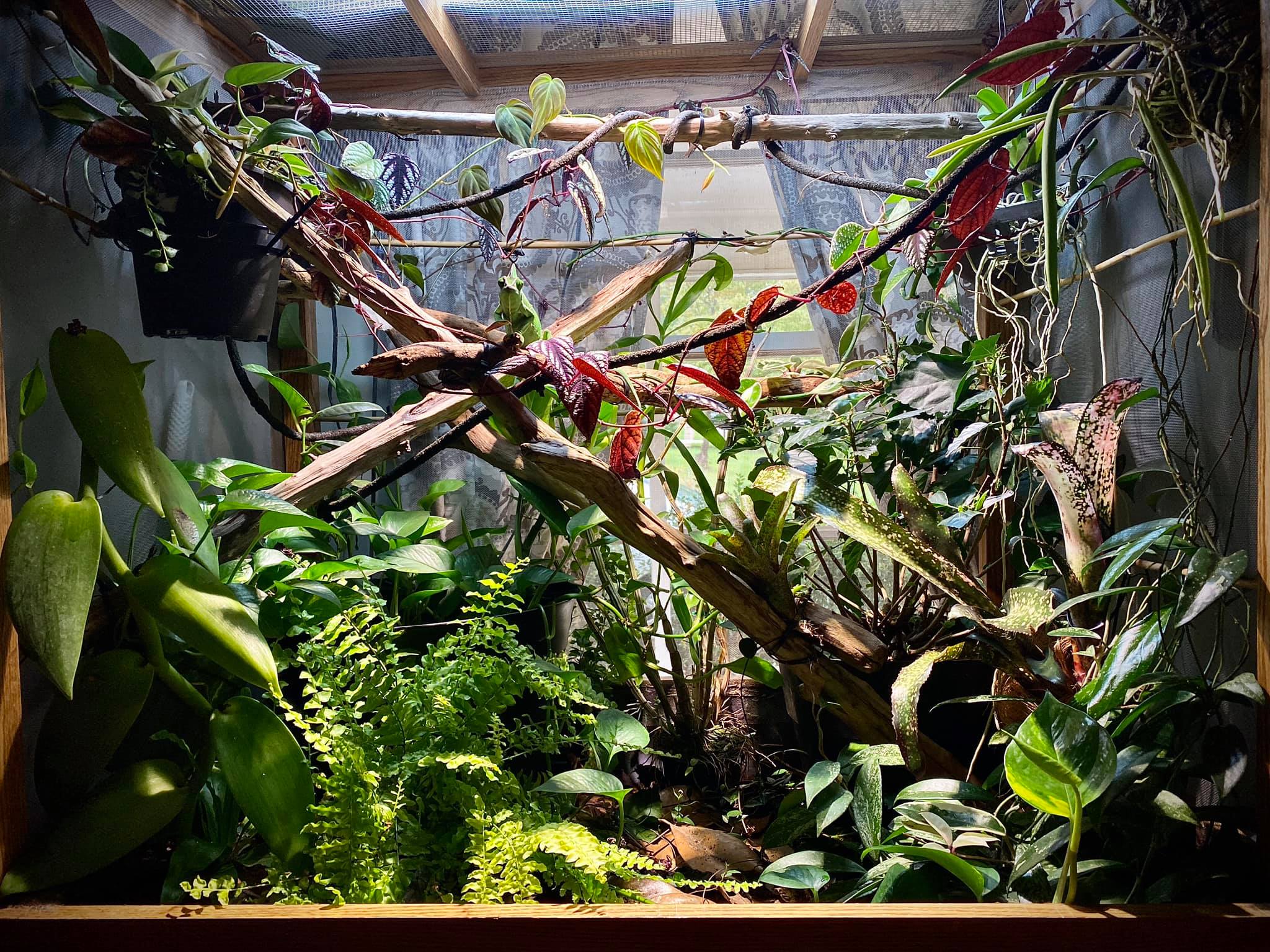The Complete Guide to Setting Up the Ideal Chameleon Enclosure
Posted on 15-11-2023 05:30 PM

Owning a pet chameleon can be an incredibly rewarding experience. As you watch your mini dinosaur stalk crickets, catch them with its lightning-fast tongue, and curl its prehensile tail around branches, you’ll be endlessly fascinated by these unique reptiles.
However, chameleons also require some very specific care in order to thrive in captivity. Arguably the most important factor in their wellbeing is setting up a proper enclosure.
This complete guide will walk you through everything you need to know to create the ideal habitat for your pet chameleon. We’ll cover suitable enclosures, placement, lighting, humidity, furnishings, plants, and equipment. Follow these steps and you’ll give your chameleon the very best shot at a long, healthy, and enriching life.
An Introduction to Chameleon Habitat Needs
In the wild, most chameleons are arboreal, meaning they live in trees and shrubs. They cling to branches and vines with their specialized feet and prehensile tails.
Chameleons native to places like Madagascar and Yemen thrive in warm, humid, tropical environments filled with lush plant growth. They bask in sunlight filtering through the canopy, drink tiny droplets of water formed on leaves, and hide amongst dense foliage.
To keep a chameleon healthy in captivity, it's critical to recreate key elements of their natural habitat:
- Warm basking area
- UVB light
- Appropriate day/night temperature gradient
- Moderate to high humidity
- Enclosure large enough for a range of microclimates
- Plenty of vines, branches, and leaves for climbing, basking, and hiding
- A way to provide drinking water mimicking droplets on leaves
- Good ventilation and air flow
Get these habitat factors right, and you’ll have happy, healthy chameleon. Get them wrong, and you risk problems including dehydration, respiratory infections, eye problems, and more.
That’s why setting up the right enclosure is so important.
Below we’ll explore in detail how to provide everything your pet chameleon needs to thrive.
Choosing the Right Chameleon Cage
The first step in setting up a chameleon habitat is selecting an appropriate cage or enclosure. The main options are screen, glass, or hybrid enclosures.
Screen Cages
Open screen cages made from wire or aluminum mesh are a popular choice, especially for common varieties like veiled chameleons. Screen cages provide maximum airflow and ventilation. This helps prevent buildup of humidity while still allowing you to create the right level of moisture.
However, screen cages alone can make it more difficult to control temperature. And in drier climates, maintaining humidity inside a screen enclosure can be challenging.

Veiled chameleons do well in open screen cages.
Glass Terrariums
Glass reptile terrariums retain heat and humidity much better than screen cages. They allow you to create a tropical environment if you live in a cooler or drier climate.
However, glass terrariums limit air circulation. You’ll need to pay close attention to ventilating the habitat and preventing condensation buildup, which can lead to respiratory infections.

Hybrid Cages
The best of both worlds is often a hybrid screen and glass enclosure. Many have front-opening glass doors with screened sides and top. These cages give you more control over the environment while still providing ample airflow.
Popular hybrid cage options include:
- Exo Terra glass terrariums
- Zoo Med Reptibreeze open screen with glass front cages
- LLL Reptile screen & glass cages
- Apogee aluminum screen & glass cages
The Exo Terra cage combines glass doors with screened sides and top.
Cage Size
Bigger is always better when it comes to chameleon cages. Adult chameleons of most common species should have a minimum enclosure size around 2 ft x 2 ft x 4 ft tall (width x depth x height).
This allows room for the chameleon to thermoregulate and find cooler, shadier areas when needed. It also provides enough space to create the ideal environment including basking, humidity, and hiding areas.
For a large, active male panther or veiled chameleon, a cage larger than the minimum like 2 ft x 3 ft x 6 ft tall is ideal.
Never house more than one chameleon per cage, even if they are a bonded pair.
Where to Place the Chameleon Habitat
Once you choose an appropriate cage, the next step is deciding where to put it. The location of your chameleon's enclosure in your home can impact its stress levels and comfort.
Avoid High Traffic Areas
Chameleons prefer calm, peaceful environments. Placing a chameleon cage in a high traffic area like a living room will expose them to excessive noise and movement.
This can chronically stress chameleons, leading to poor appetite and health over time.
Instead, set up the enclosure in a quiet room with minimal foot traffic and activity. A spare bedroom or dedicated reptile room is ideal.
Elevate the Cage
Also elevate the cage off the floor so it sits above the height of people walking by and other pets.
Chameleons like having the high ground to survey their domain. A tall cage placed on a sturdy table or stand makes them feel more secure.
Elevating your chameleon's cage reduces stress and makes them feel secure.

Critical Chameleon Lighting Setup
Arguably the most important part of a chameleon habitat is the lighting. In the wild, chameleons thermoregulate and get vitamin D3 for calcium absorption by moving in and out of bright sunlight filtered through the tree canopy.
In captivity a chameleon's lighting setup must provide:
- Heat from overhead basking bulbs
- UVB for calcium metabolism
- Visible light for their vision and mental health
Getting the lighting right is crucial to your chameleon's health. Follow these steps:
Step 1: Choose UVB Bulb
UVB bulbs for chameleons should be tube-style fluorescent or compact fluorescent bulbs specifically made for reptiles.
Never use coil-type bulbs - these can damage chameleon eyes.
For most common species like panther, veiled, or Jackson's chameleons, choose a 5.0 UVB tube. Bulbs are labeled with their UVB output, such as "Zoo Med Reptisun 5.0 UVB."
A linear fluorescent 5.0 UVB bulb provides safe UVB levels for chameleons.
Step 2: Place UVB Bulb
Mount the UVB bulb inside a screen cage. If using a glass terrarium, choose a lower 3% or 5% UVB bulb and place it outside the cage to prevent filtering.
Install the UVB tube to span 3⁄4 to the full width of the cage. This ensures UVB exposure across basking sites.
The bulb should be 12-15 inches above the highest basking perch, measured from chameleon back to light. This provides ideal UVB exposure levels for most species based on research.
Follow manufacturer mounting guidelines. Use a reflector to direct UVB downward.
Step 3: Add Basking Bulb
Chameleons need overhead heat to bask and raise their body temperature, just like how we need a heater and the sun.
Provide heat with a halogen basking bulb designed for reptiles. Aim for a basking temperature of:
- 85-90°F for panther and veiled chameleons
- 75-80°F for Jackson's chameleons
Use a clamp lamp and point it straight down on a basking branch or vine 10-12 inches below the bulb.
Measure temperature using a digital thermometer probe placed right at the basking spot. Adjust heat lamp wattage and height as needed to reach ideal basking temp.
Overhead basking bulbs allow chameleons to raise their body temperature, like basking in the sun.
Step 4: Add Full Spectrum Bulb
Chameleons need bright full spectrum light to see properly and maintain a healthy circadian rhythm.
Use a full spectrum 6500-6700K fluorescent or LED tube or bulb for 10-12 hours a day. Mount it close beside the UVB so your chameleon can bask under both.
Step 5: Use Timers!
To ensure consistent photoperiods which are vital to chameleon health, put all lights on timers. Set UVB, basking, and full spectrum lights to come on in the morning and shut off 12 hours later.
Maintaining Proper Humidity Levels
Chameleons come from tropical environments where the air stays warm and humid year-round. Recreating these conditions in your chameleon’s habitat is crucial.
Ideal humidity levels depend slightly on species:
- Veiled chameleons: 50% during the day, 70-80% at night.
- Panther chameleons: 50% during the day, 70-80% at night.
- Jackson's chameleons: 30-40% humidity constant.
Use a digital hygrometer to monitor humidity. Place it at mid-cage height out of direct light.
Raise humidity by misting the cage daily using a spray bottle or setting up an automated misting system on a timer. Site misters to hit foliage. The water evaporating from leaves raises ambient humidity.
Allow the habitat to dry out between misting sessions. Constant dampness encourages microbial growth.
Live plants also help contribute humidity through transpiration. Include several chameleon safe plants - more on that below!

Drainage Systems Prevent Water Buildup
With all the misting required to keep humidity up, excess water must have a way to drain out of the habitat or it will saturate the cage bottom.
Water buildup leads to mold, bacteria, and respiratory infections. Prevent this with proper drainage.
For glass terrariums, drill several 1⁄4 inch holes spaced evenly across the bottom. Place the tank atop egg crate over a drainage tray. Run a bead of silicone around the inside edges of the holes to prevent leaks.
Mesh cages allow water to pass through. Simply elevate the cage above a pan or tray to catch drips.
Drilling drainage holes in the bottom of glass cages lets excess water escape to protect your chameleon's health.
Check drainage daily when misting and remove collected water to prevent overflow.
Essential Chameleon Habitat Furnishings
In addition to environment, your chameleon needs enriching cage furnishings to truly thrive including:
- Branches and vines - For climbing, basking, feeding, and perching
- Live or artificial plants - For cover and climbing
- Substrate - Floor covering to maintain cleanliness
- Hides - So the chameleon can feel secure
Let's look at how to provide all these interior elements:
Branches and Vines
Chameleons love to climb! Make sure your habitat has:
- A variety of branch diameters - From pencil-width to 1⁄2 inch max for grasping
- Horizontal perches since chameleons perch horizontally naturally
- Diagonal and curved branches to mimic the wild
- Natural wood, cleaned and dried
Affix branches using zip ties passed through cage mesh or glass terrarium cross ventilation wire.
Add flexible grapevine and bendable vines to provide more routing options.
Give your chameleon plenty of routes to move through their habitat with vines and natural wood perches.
Plants for Cover and Climbing
Live or silk plants provide hiding spots, climbing, visual barriers, and help raise humidity.
- Use large plants to create covered areas
- Position plants strategically to create climbing routes between perches
- Avoid pesticide-treated plants
Great chameleon safe live plants include:
- Pothos
- Schefflera
- Umbrella plant
- Ficus
- Yucca
- Dracaena
Water live plants from below to prevent pooling water in cages. Remove dead leaves before they rot.
Packing the habitat with live plants provides security, climbing, food sources, and humidity.
Substrates and Flooring
Chameleons don’t require any loose substrates like soils, sands, or wood chips. These can become nibbled on, cause impactions, or grow bacteria when wet.
Simple, easy to clean flooring is best:
- Reptile carpets - Easy to remove and clean
- Paper towels - Replace when soiled
- Shelf liner - Low cost disposable option
- Terrarium liner - Textured reusable plastic
Avoid substrates like moss, mulch, or coconut fiber that stay damp and grow mold.
Hides and Decor
Hides and decorations allow chameleons opportunities to feel secure and fully relax.
Provide:
- Dense foliage areas for hiding in plain sight
- Bamboo huts mounted off-floor
- Cork bark tubes of various sizes
- Artificial leaves and vines
The more covered nooks, the better so chameleons can choose different spots each day.
The Best Plants for Chameleon Enclosures
Live plants provide many benefits inside a chameleon habitat. They:
- Raise humidity through transpiration
- Give visual barriers and hiding spots
- Provide climbing routes between perches
- Help clean air of chemicals
- Look lush and naturalistic!
But you have to choose chameleon safe plants. Some popular houseplants are actually toxic.
The best plants for chameleon enclosures are:
Pothos
Also called Devil’s Ivy, pothos is readily available, low light tolerant, and has heart-shaped leaves chameleons love to hide amongst and drink from. Trailing varieties work great.
Schefflera
An umbrella plant, Schefflera features glossy green leaves in clusters along branching stems. It tolerates lower light but thrives with supporting full spectrum bulbs.

Ficus
Ficus benjamina is a popular weeping fig. Its tiny ovate leaves provide excellent cover. Other figs like Ficus pumila work well too. Give them good light. Avoid the common houseplant rubber plant (F. elastica) as it's mildly toxic.
Umbrella Plant
Not to be confused with Schefflera, the umbrella plant has thick, waxy, lance-shaped leaves. It tolerates lower light but provides less cover for hiding.
Here is the continuation of the article:
Yucca
Yuccas are drought tolerant desert plants with sword-shaped leaves. Many varieties have sharp tips so place out of reach. Provide plenty of light for these.
Dracaena
Dracaena houseplants like the compact Janet Craig cultivar have strappy leaves and are tolerant to lower light and humidity. Avoid corn plant (D. fragrans) as it's toxic.
Bromeliads
Bromeliads make great cage plants with colorful leaves and don't require high humidity. Ensure species chosen aren't sharp. Give very bright light.
When using live plants, avoid treating them with pesticides. Rinse leaves before adding to cage. Remove dead leaves promptly to prevent mold.
Necessary Equipment for Chameleon Habitats
To maintain proper conditions, monitor your chameleon, and automate key tasks, certain pieces of habitat equipment are essential:
- Timer power strip - To control photoperiods
- Temperature gun - To check basking spot temps
- Digital thermometer - Monitors ambient temps
- Digital hygrometer - Monitors humidity
- Automatic mister - Provides hydration
- Drip system - Alternative hydration
Don't skip these vital gadgets - they are central to keeping conditions ideal.
Conclusion: Follow These Steps for a Healthy Chameleon Habitat
Setting up the optimal enclosure is one of the most important duties as a chameleon owner. Follow this complete guide covering cage selection, lighting, humidity, plants, and accessories to provide your pet chameleon with everything they need to stay healthy and happy.
The key steps include:
- Choose an appropriate screen, glass, or hybrid cage at least 2 x 2 x 4 feet size
- Place the enclosure in a quiet room elevated off the floor
- Install UVB, basking, and full spectrum lighting on timers
- Use a mister and live plants to maintain 50-80% humidity
- Create a drainage system to remove excess water
- Add branches, vines, plants, and hides for enrichment
- Choose only chameleon-safe plants and avoid pesticides
- Use equipment like a hygrometer and thermometer to monitor conditions
While it takes some work up front, setting up a proper chameleon habitat will reward you with a bold and interactive pet. Nothing beats the fascination of living with these colorful characters! Their amazing looks and behaviors will entertain you endlessly.